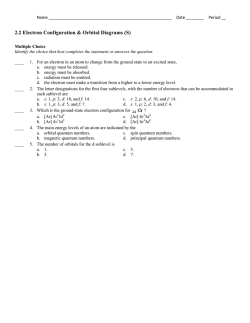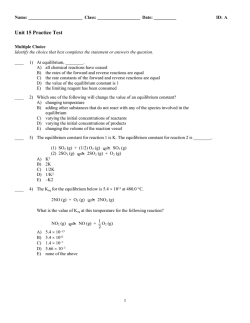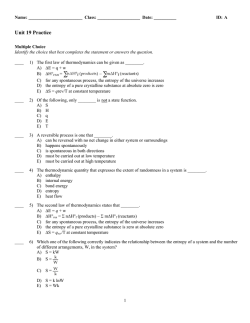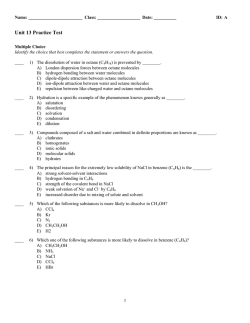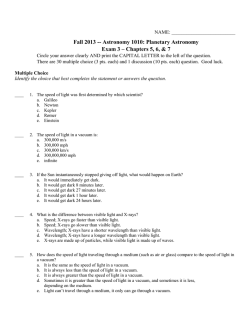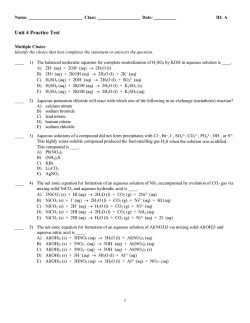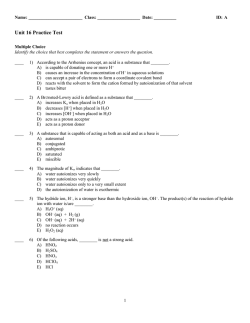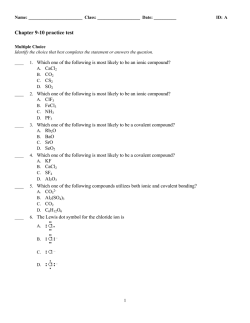
ExamView - Untitled.tst
Name: ________________________ Class: ___________________ Date: __________ ID: A Unit 9 Practice Multiple Choice Identify the choice that best completes the statement or answers the question. ____ 1) The basis of the VSEPR model of molecular bonding is ____. A) regions of electron density on an atom will organize themselves so as to maximize s-character B) regions of electron density in the valence shell of an atom will arrange themselves so as to maximize overlap C) atomic orbitals of the bonding atoms must overlap for a bond to form D) electron domains in the valence shell of an atom will arrange themselves so as to minimize repulsions E) hybrid orbitals will form as necessary to, as closely as possible, achieve spherical symmetry ____ 2) The electron-domain geometry of ____ is tetrahedral. A) CBr4 B) PH3 C) CCl2Br2 D) XeF4 E) all of the above except XeF4 ____ 3) The bond angles marked a, b, and c in the molecule below are about ____, ____, and ____, respectively. A) B) C) D) E) ____ 109.5°, 109.5°, 109.5° 120°, 109.5°, 120° 109.5°, 109.5°, 120° 90°, 180°, 90° 109.5°, 109.5°, 90° 4) A molecule has the formula AB3 and the central atom is in a different plane from the surrounding three atoms. Its molecular shape is ____. A) tetrahedral B) trigonal pyramidal C) linear D) T-shaped E) bent 1 Name: ________________________ ID: A ____ 5) Three monosulfur fluorides are observed: SF 2, SF4, and SF6. Of these, ____ is/are polar. A) SF2 only B) SF2 and SF4 only C) SF4 only D) SF6 only E) SF2, SF4, and SF6 ____ 6) The molecular geometry of the BCl3 molecule is ____, and this molecule is ____. A) trigonal pyramidal, polar B) trigonal pyramidal, nonpolar C) trigonal planar, polar D) trigonal planar, nonpolar E) trigonal bipyramidal, polar ____ 7) The hybridizations of iodine in IF 3 and IF5 are ____ and ____, respectively. A) sp3, sp3d B) sp3d, sp3d2 C) sp3d, sp3 D) sp3d2, sp3d E) sp3d2, sp3d2 ____ 8) The electron-domain geometry of the AsF5 molecule is trigonal bipyramidal. The hybrid orbitals used by the As atom for bonding are ____ orbitals. A) sp2d2 B) sp3 C) sp3d2 D) sp3d E) sp2 ____ 9) A typical double bond ____. A) is stronger and shorter than a single bond B) consists of one bond and one bond C) imparts rigidity to a molecule D) consists of two shared electron pairs E) All of the above answers are correct. ____ 10) Which of the following molecules or ions will exhibit delocalized bonding? SO3 SO32SO2 2A) SO2, SO3, and SO3 B) SO32- only C) SO2 and SO3 D) SO3 and SO32E) None of the above will exhibit delocalized bonding. ____ 11) The hybridization of the terminal carbons in the H 2C C CH2 molecule is ____. A) sp B) sp2 C) sp3 D) sp3d E) sp3d2 2 Name: ________________________ ID: A ____ 12) The bond order of any molecule containing equal numbers of bonding and antibonding electrons is ____. A) 0 B) 1 C) 2 D) 3 E) 1/2 ____ 13) Based on molecular orbital theory, the bond order of the H—H bond in the H 2+ ion is ____. A) 0 B) 1/2 C) 1 D) 3/2 E) 2 ____ 14) Molecular Orbital theory correctly predicts paramagnetism of oxygen gas, O 2. This is because ____. A) the bond order in O 2 can be shown to be equal to 2. B) there are more electrons in the bonding orbitals than in the antibonding orbitals. C) the energy of the 2p MOs is higher than that of the 2p MO D) there are two unpaired electrons in the MO electron configuration of O 2 E) the O—O bond distance is relatively short ____ 15) Of the following, only ____ appears to gain mass in a magnetic field. A) C2 B) N2 C) F2 D) O2 E) Li2 ____ 16) The bond order of a homonuclear diatomic molecule can be decreased by ____. A) removing electrons from a bonding MO or adding electrons to an antibonding MO B) adding electrons to a bonding MO or removing electrons from an antibonding MO C) adding electrons to any MO D) removing electrons from any MO E) The bond order of a homonuclear diatomic molecule cannot be decreased by any means. ____ 17) For a molecule with the formula AB2, the molecular shape is ____. A) linear or bent B) linear or trigonal planar C) linear or T-shaped D) T-shaped E) trigonal planar ____ 18) The molecular geometry of the SiH2Cl2 molecule is ____. A) trigonal planar B) tetrahedral C) trigonal pyramidal D) octahedral E) T-shaped 3 Name: ________________________ ID: A ____ 19) The O-S-O bond angle in SO2 is slightly less than ____. A) 90° B) 109.5° C) 120° D) 180° E) 60° ____ 20) The hybridization of orbitals on the central atom in a molecule is sp. The electron-domain geometry around this central atom is ____. A) octahedral B) linear C) trigonal planar D) trigonal bipyramidal E) tetrahedral ____ 21) The electron-domain geometry of the AsF6- ion is octahedral. The hybrid orbitals used by the As atom for bonding are ____ orbitals. A) sp2d2 B) sp3 C) sp3d D) sp3d2 E) sp2 ____ 22) There are ____ and ____ bonds in the H—CC—H molecule. A) 3 and 2 B) 3 and 4 C) 4 and 3 D) 2 and 3 E) 5 and 0 ____ 23) There is/are ____ bond(s) in the molecule below. A) B) C) D) E) 7 6 2 1 0 4 Name: ________________________ ID: A ____ 24) The central atom in the ICl4- ion has ____ nonbonded electron pair(s) and ____ bonded electron pair(s) in its valence shell. A) 4, 2 B) 0, 4 C) 2, 4 D) 2, 2 E) 6, 0 ____ 25) The electron-domain geometry and molecular geometry of the nitrite ion are ____ and ____, respectively. A) trigonal bipyramidal, trigonal planar B) tetrahedral, trigonal pyramidal C) trigonal bipyramidal,T-shaped D) trigonal planar, bent E) T-shaped, trigonal planar ____ 26) Using the VSEPR model, the molecular geometry of the central atom in SO 3 is ____. A) linear B) trigonal planar C) tetrahedral D) bent E) trigonal pyramidal ____ 27) Of the molecules below, only ____ is polar. A) CO2 B) CH4 C) PF5 D) SnF3 E) H2 ____ 28) According to valence bond theory, which orbitals overlap in the formation of the bond in Br 2? A) 3s B) 3p C) 4s D) 4p E) 3d ____ 29) There is/are ____ hybridized s atomic orbital(s) in an sp-hybridized carbon atom. A) 4 B) 0 C) 3 D) 1 E) 2 ____ 30) Based on molecular orbital theory, the bond order of the N—N bond in the N 2 molecule is ____. A) 0 B) 1/2 C) 3 D) 2 E) 1 5 Name: ________________________ ID: A ____ 31) In molecular orbital theory, the bond order of the He—He bond in He 2 is ____. A) 0 B) 2 C) He—He D) 1 E) 1/2 Short Answer 1) What is the molecular geometry of a molecule that has three bonding and two non-bonding domains? 2) In the valence shell of an atom there are six electron domains. They will be arranged in a(n) ________ geometry. 3) What are the three bond angles in the trigonal bipyramidal structure? 4) Three molecules have similar electron domains, but different molecular shapes. Why? 5) The 1s hydrogen orbital overlaps with the ________ iodine orbital in HI. 6) A covalent bond in which overlap regions lie above and below an internuclear axis is called a(n) ________. 7) The sensation of vision results from a nerve impulse that is triggered by the separation of retinal from ________. 8) In molecular orbital theory, the stability of a covalent body is related to its ________. 9) Each molecular orbital can accommodate, at most, two electrons with their spins paired. This is called the ________. 10) The more unpaired electrons in a species, the stronger is the force of magnetic attraction. This is called ________. True/False Indicate whether the statement is true or false. ____ 1) Possible shapes of AB3 molecules are linear, trigonal planar, and T-shaped. ____ 2) Boron trifluoride has three bonding domains, and its electron domain geometry is trigonal planar. ____ 3) Electron domains for single bonds exert greater force on adjacent domains than the electron domains for multiple bonds. ____ 4) The quantitative amount of charge separation in a diatomic molecule contributes to the dipole moment of that molecule. 6 Name: ________________________ ID: A ____ 5) XeF4 is a polar molecule. ____ 6) Hybridization is the process of mixing atomic orbitals as atoms approach each other to form a bond. ____ 7) Electrons in core orbitals contribute to atom bonding. ____ 8) Nitrogen is colorless because the minimum energy to excite an electron is in the ultraviolet section of the spectrum. 7 ID: A Unit 9 Practice Answer Section MULTIPLE CHOICE 1) ANS: OBJ: 2) ANS: OBJ: 3) ANS: OBJ: 4) ANS: OBJ: 5) ANS: OBJ: 6) ANS: OBJ: 7) ANS: OBJ: 8) ANS: OBJ: 9) ANS: OBJ: 10) ANS: OBJ: 11) ANS: OBJ: 12) ANS: OBJ: 13) ANS: OBJ: 14) ANS: OBJ: 15) ANS: OBJ: 16) ANS: OBJ: 17) ANS: OBJ: 18) ANS: OBJ: 19) ANS: OBJ: 20) ANS: OBJ: 21) ANS: OBJ: D 9.2; G2 E 9.2; G2 C 9.2; G2 B 9.2; G2 B 9.3; G2 D 9.3; G2 B 9.5; G2 D 9.5; G2 E 9.6; G2 C 9.6; G2 B 9.6; G2 A 9.7; G2 B 9.7; G2 D 9.7, 9.8; G2 D 9.8; G2 A 9.8; G2 A 9.2; G2 B 9.2; G2 C 9.2; G2 B 9.5; G2 D 9.5; G2 PTS: 1 DIF: 1 REF: Page Ref: 9.2 PTS: 1 DIF: 2 REF: Page Ref: 9.2 PTS: 1 DIF: 2 REF: Page Ref: 9.2 PTS: 1 DIF: 2 REF: Page Ref: 9.2 PTS: 1 DIF: 2 REF: Page Ref: 9.3 PTS: 1 DIF: 1 REF: Page Ref: 9.3 PTS: 1 DIF: 1 REF: Page Ref: 9.5 PTS: 1 DIF: 1 REF: Page Ref: 9.5 PTS: 1 DIF: 1 REF: Page Ref: 9.6 PTS: 1 DIF: 1 REF: Page Ref: 9.6 PTS: 1 DIF: 2 REF: Page Ref: 9.6 PTS: 1 DIF: 3 REF: Page Ref: 9.7 PTS: 1 DIF: 4 REF: Page Ref: 9.7 PTS: 1 DIF: 4 REF: Page Ref: 9.7-9.8 PTS: 1 DIF: 4 REF: Page Ref: 9.8 PTS: 1 DIF: 4 REF: Page Ref: 9.8 PTS: 1 DIF: 1 REF: Page Ref: 9.1 PTS: 1 DIF: 1 REF: Page Ref: 9.2 PTS: 1 DIF: 1 REF: Page Ref: 9.2 PTS: 1 DIF: 1 REF: Page Ref: 9.5 PTS: 1 DIF: 2 REF: Page Ref: 9.5 1 ID: A 22) ANS: OBJ: 23) ANS: OBJ: 24) ANS: OBJ: 25) ANS: OBJ: 26) ANS: OBJ: 27) ANS: OBJ: 28) ANS: OBJ: 29) ANS: OBJ: 30) ANS: OBJ: 31) ANS: OBJ: A 9.6; G2 D 9.6; G2 C 9.2; G2 D 9.2; G2 B 9.2; G2 D 9.3; G2 D 9.4; G2 D 9.5; G2 C 9.7, 9.8; G2 C 9.7, 9.8; G2 PTS: 1 DIF: 1 REF: Page Ref: 9.6 PTS: 1 DIF: 1 REF: Page Ref: 9.6 PTS: 1 DIF: 1 REF: Page Ref: 9.2 PTS: 1 DIF: 1 REF: Page Ref: 9.2 PTS: 1 DIF: 1 REF: Page Ref: 9.2 PTS: 1 DIF: 2 REF: Page Ref: 9.3 PTS: 1 DIF: 1 REF: Page Ref: 9.4 PTS: 1 DIF: 1 REF: Page Ref: 9.5 PTS: 1 DIF: 4 REF: Page Ref: 9.8 PTS: 1 DIF: 1 REF: Page Ref: 9.7-9.8 PTS: 1 OBJ: 9.2; G2 2) ANS: octahedral DIF: 4 REF: Page Ref: 9.2 PTS: 1 OBJ: 9.2; G2 3) ANS: 90°, 120°, 180° DIF: 5 REF: Page Ref: 9.2 SHORT ANSWER 1) ANS: T-shaped PTS: 1 DIF: 4 REF: Page Ref: 9.2 OBJ: 9.2; G2 4) ANS: different numbers of non-bonding domains PTS: 1 OBJ: 9.2; G2 5) ANS: 5p DIF: 4 REF: Page Ref: 9.2 PTS: 1 OBJ: 9.5; G2 DIF: 2 REF: Page Ref: 9.5 2 ID: A 6) ANS: bond PTS: 1 OBJ: 9.6; G2 7) ANS: opsin DIF: 2 REF: Page Ref: 9.6 PTS: 1 OBJ: 9.6; G2 8) ANS: bond order DIF: 2 REF: Page Ref: 9.6 PTS: 1 OBJ: 9.7; G2 9) ANS: Pauli principle DIF: 2 REF: Page Ref: 9.7 PTS: 1 OBJ: 9.8; G2 10) ANS: paramagnetism DIF: 4 REF: Page Ref: 9.8 PTS: 1 OBJ: 9.8; G2 DIF: 1 REF: Page Ref: 9.8 PTS: 1 DIF: 2 REF: Page Ref: 9.1 PTS: 1 DIF: 2 REF: Page Ref: 9.2 PTS: 1 DIF: 1 REF: Page Ref: 9.2 PTS: 1 DIF: 1 REF: Page Ref: 9.3 PTS: 1 DIF: 3 REF: Page Ref: 9.3 PTS: 1 DIF: 1 REF: Page Ref: 9.5 PTS: 1 DIF: 1 REF: Page Ref: 9.6 PTS: 1 DIF: 3 REF: Page Ref: 9.8 TRUE/FALSE 1) ANS: OBJ: 2) ANS: OBJ: 3) ANS: OBJ: 4) ANS: OBJ: 5) ANS: OBJ: 6) ANS: OBJ: 7) ANS: OBJ: 8) ANS: OBJ: F 9.2; G2 T 9.2; G2 F 9.2; G2 T 9.3; G2 F 9.3; G2 T 9.5; G2 F 9.6; G2 T 9.8; G2 3 Unit 9 Practice [Answer Strip] ID: A B _____ 5) A 12) _____ C 19) _____ D _____ 6) B 13) _____ B 20) _____ B _____ 7) D 14) _____ D _____ 8) D 15) _____ D _____ 1) C 24) _____ D 25) _____ D 21) _____ B 26) _____ E _____ 2) D 27) _____ A 22) _____ C _____ 3) E _____ 9) C 10) _____ A 16) _____ D 23) _____ A 17) _____ D 28) _____ D 29) _____ B _____ 4) B 18) _____ B 11) _____ C 30) _____ Unit 9 Practice [Answer Strip] C 31) _____ F _____ 5) T _____ 6) F _____ 7) T _____ 8) F _____ 1) T _____ 2) F _____ 3) T _____ 4) ID: A
© Copyright 2024
